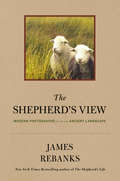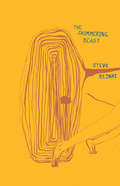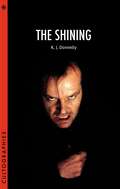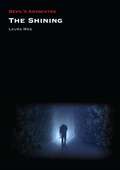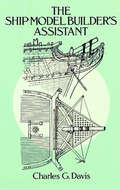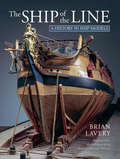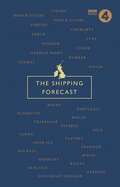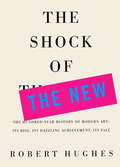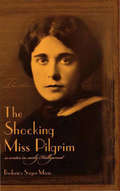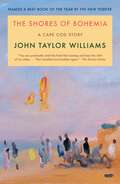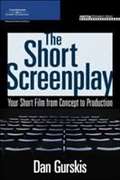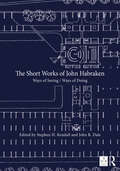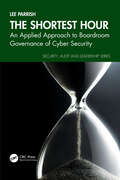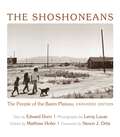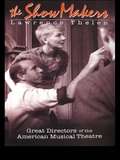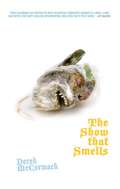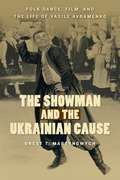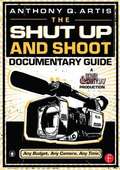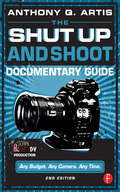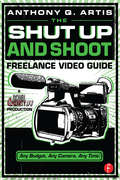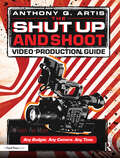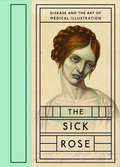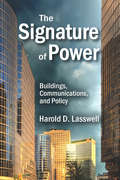- Table View
- List View
The Shepherd's View: Modern Photographs From an Ancient Landscape
by James RebanksFrom The New York Times bestselling author of The Shepherd's Life, a breathtaking book of photography and wisdom that chronicles an ancient way of living that deeply resonates in our modern world. With over eighty full color photographs The English Lake District comes into full focus: the sheep competitions of the spring, the sweeping pastures of the summer, beloved sheep dogs in the fall and the harsh snows of winter. A celebration of a way of life still very much alive, The Shepherd's View is a poetic, and artistic achievement from one of England's most celebrated new voices.
The Shimmering Beast
by Steve ReinkeSteve Reinke is one of the most intriguing artists we've got; his scope is enormous, his imagination absolutely singular. His video art -- The Hundred Videos, Anthology of American Folk Song, Anal Masturbation and Object Loss -- practically define the genre. Reinke tells us, in 'Kitchener-Berlin,' his appreciation of Philip Hoffman's film of that title, that experimental video is centred around voice -- a decidedly peculiar and literary notion. It makes good sense, then, that this experimental video artist is also an accomplished prose writer. Collected herein are Reinke's best recent prose pieces. Hybrids of criticism, fiction and personal essay, these pieces all engage -- by pillaging, by honouring, by scrutinizing, by cannibalizing -- an other's work: the films of Frank Cole, the videos of Emily Vey Duke and Cooper Battersby, the photos of Douglas Ischar, the writings of Dr. Paul Brouardel and the psychoanalysis of Melanie Klein, to name just a few. Funny, absurd and tartly poignant, these texts document the process and reach of an artistic mind at the height of its powers.
The Shining (Cultographies)
by Kevin J. DonnellyStanley Kubrick’s The Shining (1980) is an esteemed member of the twentieth century’s pantheon of outstanding films while also perhaps being the director’s most accessible film. It is a rarity in that on the one hand it was a successful mainstream horror film about a violent father in a deserted and haunted hotel, but on the other is a more rarefied and esoteric object for cult audiences who are convinced that the film means something totally different. Indeed, the film appears replete with enigmatic and provocative allusions, which provide The Shining with an almost unmatched sense of resonance. Seeing the film as a vehicle for secret messages has led to a myriad of different interpretations, which has helped elevate the film’s cult status over the years to make it a special case in cinema. Indeed, it is so singular that it arguably even redefines the notion of cult film. This volume investigates The Shining’s most fascinating aspects as a film while also addressing the range of meanings and interpretations assigned to the film, looking into what has made it one of the key cult films of the last half century.
The Shining (Devil's Advocates)
by Laura MeeTaking a fresh look at The Shining (1980), this book situates the film within the history of the horror genre and examines its rightful status as one of the greatest horror movies ever made. It explores how Stanley Kubrick's filmmaking style, use of dark humor, and ambiguous approach to supernatural storytelling complements generic conventions, and it analyzes the effective choices made in adapting King's book for the screen—stripping the novel's backstory, rejecting its clear explanations of the Overlook Hotel's hauntings, and emphasizing the strained relationships of the Torrance family. The fractured family unit and patriarchal terror of Kubrick's film, alongside its allusions to issues of gender, race, and class, connect it to themes prevalent in horror cinema by the end of the 1970s, and are shown to offer a critique of American society that chimed with the era's political climate as well as its genre trends. The film's impact on horror cinema and broader pop culture is ever apparent, with homages in everything from Toy Story to American Horror Story. The Shining showed that popular, commercial horror films could be smart, artistic, and original.
The Ship Model Builder's Assistant
by Charles G. DavisIndispensable for the serious model builder, this book offers hobbyists a true understanding of the masting, rigging, and most important fittings of American clipper ships and packet ships of the Great Age of Sail. It also represents a treasury of important information for naval and social historians, sailing enthusiasts, and students of Americana. Enhanced with over 270 clear, detailed drawings of ships' components, this volume gives the model builder a deep understanding of the workings of a fully rigged and appointed sailing ship. After initial chapters on varying types of ship models, including the built-up model and wooden-sail models, the author devotes individual chapters to the masting of ships, mastheads, the standing rigging, the running rigging, foot-ropes, the blocks, steering wheels, the ship's galley, pumps, ship ironwork, copper sheathing, the ground tackle, gun ports, boats, and davits. He includes as well invaluable tables and lists of data that offer opportunities to compare vital statistics on rigging, masting, and more. Charles G. Davis was a well-known naval architect, shipbuilder, master seaman, racing yachtsman, and nautical chronicler. His lifelong love affair with the great ships of the past resulted in several classic works on ships and ship model building. The present volume is one of the latter, an extremely thorough, practical, and readable guide to building ship models in authentic detail and in proper proportion. In all, The Ship Model Builder's Assistant offers a treasury of both descriptive and "how-to" information essential to model builders and highly enlightening for all fascinated by the great sailing ships of America's past.
The Ship of the Line: A History in Ship Models (A\history In Ship Models Ser.)
by Brian Lavery&“A beautiful book . . . a goldmine of information to anyone interested in the capital ships of the sailing navy of the 17th and 19th Centuries.&”—Ships in Scale The National Maritime Museum in Greenwich houses the largest collection of scale ship models in the world, many of which are official, contemporary artifacts made by the craftsmen of the navy or the shipbuilders themselves, and ranging from the mid-seventeenth century to the present day. As such they represent a three-dimensional archive of unique importance and authority. Treated as historical evidence, they offer more detail than even the best plans, and demonstrate exactly what the ships looked like in a way that even the finest marine painter could not achieve. The Ship of the Line is the second of a new series that takes selections of the best models to tell the story of specific ship types—in this case, the evolution of the ship of the line, the capital ship of its day, and the epitome of British seapower during its heyday from 1650-1850. This period also coincided with the golden age of ship modelling. Each volume depicts a wide range of models, all shown in full color, including many close-up and detail views. These are captioned in depth, but many are also annotated to focus attention on interesting or unusual features, and the book weaves the pictures into an authoritative text, producing a unique form of technical history. The series is of particular interest to ship modellers, but all those with an enthusiasm for the ship design and development in the sailing era will attracted to the in-depth analysis of these beautifully presented books.
The Shipping Forecast: A Miscellany
by Nic ComptonThe rhythmic lullaby of ‘North Utsire, South Utsire’ has been lulling the nation’s insomniacs to sleep for over 90 years. It has inspired songs, poetry and imaginations across the globe – as well as providing a very real service for the nation’s seafarers who might fall prey to storms and gales. It has inspired everyone from Seamus Heaney to Radiohead, and from Radio 4 announcers to the writers of Keeping Up Appearances. In 1995, a plan to move the late-night broadcast by just 12 minutes caused a national outcry and was ultimately scrapped.Published with Radio 4 and the Met Office, The Shipping Forecast is the official miscellany for seafarers and armchair travellers alike. It features fascinating facts alongside lyrics from Seamus Heaney, Carol Ann Duffy, Radiohead and more. From the places themselves – how they got their names, what’s happened there through the ages – to the poems and parodies that it’s inspired, this is a beautifully evocative tribute to one of Britain's – and Radio 4's – best-loved broadcasts.
The Shock of the New
by Robert HughesA beautifully illustrated hundred-year history of modern art, from cubism to pop and avant-guard. More than 250 color photos.From the Trade Paperback edition.
The Shocking Miss Pilgrim: A Writer in Early Hollywood
by Frederica Sagor MaasA memoir of the rise and fall of one female screenwriter&’s career during the Golden Age of Hollywood. Freddie Maas&’s revealing memoir offers a unique perspective on the film industry and Hollywood culture in their early days and illuminates the plight of Hollywood writers working within the studio system. An ambitious twenty-three-year-old, Maas moved to Hollywood and launched her own writing career by drafting a screenplay of the bestselling novel The Plastic Age for &“It&” girl Clara Bow. With that script, she landed a staff position at powerhouse MGM studios. In the years to come, she worked with and befriended numerous actors and directors, including Norma Shearer, Joan Crawford, and Eric von Stroheim, as well as such writers and producers as Thomas Mann and Louis B. Mayer. As a professional screenwriter, Frederica quickly learned that scripts and story ideas were frequently rewritten, and that screen credit was regularly given to the wrong person. Studio executives wanted well-worn plots, but it was the writer&’s job to develop the innovative situations and scintillating dialogue that would bring to picture to life. For over twenty years, Freddie and her friends struggled to survive in this incredibly competitive environment. Through it all, Freddie remained a passionate, outspoken woman in an industry run by powerful men, and her provocative, nonconformist ways brought her success, failure, wisdom, and a wealth of stories, opinions, and insight into a fascinating period in screen history.Praise for The Shocking Miss Pilgrim &“In this memorable tell-all, rise-and-fall memoir, Maas brings the gimlet hindsight of Julia Phillips&’s You&’ll Never Eat Lunch in This Town Again to early Hollywood, and the results are thoroughly captivating.&” —Publishers Weekly &“A bittersweet, extraordinarily detailed recollection of Maas&’s 30-year career in the motion picture industry. . . . Chockablock with anecdotes, and a blinding amount of star-wattage to boot.&” —Salon.com
The Shores of Bohemia: A Cape Cod Story, 1910-1960
by John Taylor WilliamsAn intimate portrait of a legendary generation of artists, writers, activists, and dreamers who created a utopia on the shores of Cape Cod during the first half of the twentieth century.Their names are iconic: Eugene O’Neill, Willem de Kooning, Josef and Anni Albers, Emma Goldman, Mary McCarthy, Edward Hopper, Walter Gropius—the list goes on and on. Scorning the devastation that industrialization had wrought on the nation’s workforce and culture in the early decades of the twentieth century, they gathered in the streets of Greenwich Village and on the beach - fronts of Cape Cod. They began as progressives but soon turned to socialism, then communism. They founded theaters, periodicals, and art schools. They formed editorial boards that met in beach shacks and performed radical new plays in a shanty on the docks, where they could see the ocean through cracks in the floor. They welcomed the tremendous wave of talent fleeing Europe in the 1930s. At the end of their era, in the 1960s, as the postwar economy boomed, they took shelter in liberalism when the anticapitalist movement fragmented into other causes. John Taylor “Ike” Williams, who married into the Cape’s artistic world and has spent half a century talking about and walking along its shores with these cultural and political luminaries, renders the twisting lives and careers of a generation of staggering American thinkers and creators. The Shores of Bohemia records a great set of shifts in American culture and the ideas and arguments fueled by drink, infidelity, and competition that made for a fifty-year conversation among intellectual leaders and creative revolutionaries. Together they found a community as they created some of the great works of the American Century. This is their story. Welcome to the party!
The Short Screenplay: Your Short Film from Concept to Production
by Dan GurskisWith the growth of film festivals, cable networks, specialty home video, and the Internet, there are more outlets and opportunities for screening short films now than at any time in the last 100 years. But before you can screen your short film, you need to shoot it. And before you can shoot it, you need to write it. The Short Screenplay provides both beginning and experienced screenwriters with all the guidance they need to write compelling, filmable short screenplays. Explore how to develop characters that an audience can identify with. How to create a narrative structure that fits a short time frame but still engages the audience. How to write dialogue that's concise and memorable. How to develop story ideas from concept through final draft. All this and much more is covered in a unique conversational style that reads more like a novel than a "how-to" book. The book wraps up with a discussion of the role of the screenplay in the production process and with some helpful (and entertaining) sample scripts. This is the only guide you'll ever need to make your short film a reality!
The Short Works of John Habraken: Ways of Seeing / Ways of Doing (Open Building)
by Stephen H. Kendall John R. DaleThis book offers, for the first time, access to the chronological arc of John Habraken’s writing in a single collection. Few architects or scholars have so consistently and patiently pursued such a humane and culturally vital set of radical questions related to the behaviour of the built environment as N. John Habraken. From the publication of his first book in 1960, he has quietly helped redraw the map of architectural research, education, practice, design methods and theory. His insights lead us to a better understanding of how the built field works, contributing to the development of methods enabling professionals to contribute to its coherence and resilience. Following an introductory essay by the editors, placing Habraken’s work in context, this collection is organized in two sections and further organized around a number of specific themes: The Built Field; Role of the Architect; Control; Sharing Forms; Examples of Ways of Doing; Open Building; Tools; and Cultivating the Built Environment. A series of interviews with the author enable him to reflect on his journey of inquiry, research, advocacy and teaching – and the relationship between ways of seeing and ways of doing. Offering theoretical perspectives and methodological ways forward, this book will be of interest to architects, planners and urban designers tackling the challenges of the contemporary built environment that Habraken identifies, as well as educators and students.
The Shortest Hour: An Applied Approach to Boardroom Governance of Cyber Security (ISSN)
by Lee ParrishIndependent directors of corporate boards understand the importance of cyber security as a business issue. Increased regulatory requirements, the onslaught of breaches, as well as the replacement of the corporate network perimeter with more third-party partnerships have all contributed to cyber security rising to the top of enterprise risks. Yet, many directors only receive a few brief cyber security updates during the year. Moreover, many directors have devoted their careers to other important business disciplines and may not fully grasp the technical concepts of cyber security.The challenge is that many publications on board cyber security governance address the topic at such a high level that it removes the important context of the cyber security details—or covers the topic too deeply with hard-to-understand technical language. These resources may often provide lists of security questions for directors to ask of their management team, but they do not provide the answers to the questions so that actionable oversight can be performed. What I would have wanted, and why you are probably reading this book summary, is a resource that delivers the questions to ask but also provides the answers and in a narrative, easy-to-understand style.An award-winning Chief Information Security Officer with over two decades of working with multiple Fortune 500 boards, Lee Parrish provides an example-laden vision to improve cyber security governance in the boardroom. Additionally, Lee deciphers the technical jargon to increase the reader’s cyber fluency—not to make you a cyber expert but to help you be able to ask direct questions, understand the answers provided, challenge strategies, and advise on important cyber decisions.Pick up your copy of The Shortest Hour: An Applied Approach to Boardroom Governance of Cyber Security today and start your journey on achieving more effective cyber security oversight.Want to learn more? Please visit www.novelsecurity.com
The Shoshoneans: The People of the Basin-Plateau, Expanded Edition (Recencies Series: Research and Recovery in Twentieth-Century American Poetics)
by Edward Dorn Leroy LucasFirst published almost fifty years ago and long out of print, The Shoshoneans is a classic American travelogue about the Great Basin and Plateau region and the people who inhabit it, never before—or since—documented in such striking and memorable fashion. Neither a book of journalism nor a work of poetry, this powerful collaboration represents the wild wandering of a white poet and black photographer in Civil Rights era (also Vietnam War era) America through a part of the indigenous West that had resisted prior incursions. The expanded edition offers a wealth of supplemental material, much of it archival, which includes poetry, correspondence, the lecture &“The Poet, the People, the Spirit,&” and the essay &“Ed Dorn in Santa Fe.&”
The Show Makers: Great Directors of the American Musical Theatre
by Lawrence ThelenFirst published in 2004. Routledge is an imprint of Taylor & Francis, an informa company.
The Show That Smells (Little House on the Bowery #0)
by Derek McCormackDerek McCormack's most compelling work yet is his second selection in Dennis Cooper's groundbreaking Little House on the Bowery fiction series. “Derek McCormack has written a mini-masterpiece that keeps swelling with invention long after you’ve put it down.”—Guy Maddin, filmmaker class="MsoNormal">“A hilarious, strange and altogether ghoulish little freak show of a book . . . A book like The Show that Smells…demonstrates that innovative literature, if such a thing still exists, can be accessible and even fun, especially for those of us with a dark sense of humor.”-Miami Herald The most shocking story ever shown on the silver screen! It's also the tale of Jimmie—a country music singer dying of tuberculosis—and Carrie, his wife, who tries to save him by selling her soul to a devil who designs haute couture clothing! Elsa is a powerful Parisian dress designer, and a vampire. She wants to make Carrie look beautiful, smell beautiful—and then she wants to eat her! Will Carrie survive as her slave? Will Jimmie be cured? Starring a host of Hollywood's brightest stars, including Coco Chanel, Lon Chaney, and The Carter Family. The Show that Smells is a thrilling tale of hillbillies, high fashion, and horror! Derek McCormack is the author of Grab Bag (Akashic Books) and The Haunted Hillbilly (Soft Skull Press), which was named a “Best Book of the Year” by both the Village Voice and the Globe and Mail, and was a Lambda Literary Award finalist. He writes fashion and arts articles for the National Post. He lives in Toronto.
The Showman and the Ukrainian Cause: Folk Dance, Film, and the Life of Vasile Avramenko
by Orest T. MartynowychA quixotic figure, Vasile Avramenko (1895-1981) used folk culture and modern media in a life-long crusade to promote Ukraine’s struggle for independence to North American audiences. From his base in New York City, he built a network of folk dance schools and produced musical spectacles to help Ukrainian immigrants sustain their identity. His feature-length Ukrainian language films made in the 1930s with Hollywood director Edgar G. Ulmer, the “king of ethnic and B movies,” were shown throughout North America. Orest T. Martynowych’s The Showman and the Ukrainian Cause is a fascinating portrait how culture can become a political tool in a diaspora community.
The Shut Up And Shoot Documentary Guide: A Down & Dirty DV Production
by Anthony Q. ArtisSo you want to make a documentary, but think you don't have a lot of time, money, or experience? It's time to get down and dirty! Down and dirty is a filmmaking mindset. It's the mentality that forces you to be creative with your resources. It's about doing more with less. Get started NOW with this book and DVD set, a one-stop shop written by a guerrilla filmmaker, for guerrilla filmmakers. You will learn how to make your project better, faster, and cheaper. The pages are crammed with 500 full-color pictures, tips from the pros, resources, checklists and charts, making it easy to find what you need fast. The DVD includes: * Video and audio tutorials, useful forms, and interviews with leading documentary filmmakers like Albert Maysles (Grey Gardens), Sam Pollard (4 Little Girls), and others * 50+ Crazy Phat Bonus pages with jump start charts, online resources, releases, storyboards, checklists, equipment guides, and shooting procedures Here's just a small sampling of what's inside the book: * Putting together a crew * Choosing a camera * New HDV and 24P cameras * Shooting in rough neighborhoods * Interview skills and techniques * 10 ways to lower your budget * Common production forms Note: if you purchased an ebook version of The Shut Up and Shoot Documentary Guide, the material from the DVD packaged with the print version of the book is now available on a website.
The Shut Up and Shoot Documentary Guide: A Down & Dirty DV Production
by Anthony Q. ArtisSo you want to make a documentary, but think you don't have a lot of time, money, or experience? It's time to get down and dirty! Down and dirty is a filmmaking mindset. It's the mentality that forces you to be creative with your resources. It's about doing more with less. Get started NOW with this book and DVD set, a one-stop shop written by a guerrilla filmmaker, for guerrilla filmmakers. You will learn how to make your project better, faster, and cheaper. The pages are crammed with 500 full-color pictures, tips from the pros, resources, checklists and charts, making it easy to find what you need fast.The DVD includes:* Video and audio tutorials, useful forms, and interviews with leading documentary filmmakers like Albert Maysles (Grey Gardens), Sam Pollard (4 Little Girls), and others* 50+ Crazy Phat Bonus pages with jump start charts, online resources, releases, storyboards, checklists, equipment guides, and shooting proceduresHere's just a small sampling of what's inside the book:* Putting together a crew* Choosing a camera* New HDV and 24P cameras* Shooting in rough neighborhoods* Interview skills and techniques* 10 ways to lower your budget* Common production forms
The Shut Up and Shoot Freelance Video Guide: A Down And Dirty Dv Production
by Anthony Q. ArtisThe Shut Up and Shoot Freelance Video Guide is an easy-read crash course in the ins and outs and hundred little details of creating video works for hire. This ultra-friendly visual field guide for freelance videographers picks up where The Shut Up and Shoot Documentary Guide leaves off and gives you more detailed practical production strategies and solutions not found anywhere else on: * Marketing videos* Music Videos* Wedding videos* Music performance videos* Live event videos* Corporate videos...and more! Covering everything from dealing with clients, production strategies and step-by-step guidance on planning, shooting, lighting and recording the most common video-for-hire genres this book sets out to help you rise above the competition and make more money by doing quality work. Anthony Q. Artis will instill you with the "down and dirty" mindset that helps you to creatively maximize your limited resources regardless of your budget. Lavishly illustrated in full-color with real-world step-by-step visuals, The Shut Up and Shoot Freelance Video Guide is like a film school education in the form of a video cookbook. You don't need loads of money to make professional-looking videos - you need to get down and dirty! Includes access to a secret bonus Web site with: * Video and audio tutorials, useful forms, and case-study video projects from the book.* Crazy Phat Bonus Pages with Jump Start Charts, online Resources, Releases, Storyboards, Checklists, Equipment Guides and Shooting Procedures
The Shut Up and Shoot Video Production Guide: A Down & Dirty DV Production
by Anthony Q. ArtisAnthony Q. Artis is a 30-year veteran of the fi lm and TV industry whose features and TV shows have screened at the Tribeca Film Festival and the IFP Market, as well as on MTV and the Independent Film Channel. Anthony works professionally as a producer, director, and cinematographer at MightyAntMedia.com and has taught video production at New York University for two decades now. He is the author of the bestselling Shut Up and Shoot Documentary Guide (2014), The Shut Up and Shoot Freelance Video Guide (2011), and numerous fi lmmaking courses on LinkedInLearning.com . Accessible and comprehensive, this book is a great introduction on how to make movies and video projects with limited resources, time, or experience. Artis will teach readers the “Down and Dirty” filmmaking mindset, which forces fi lmmakers to be creative with their resources, do more with less, and result in a better, faster, and less expensive product. Drawing on more than 30 years of experience, Artis covers such wide-ranging topics as composition, lens choice, smartphone filmmaking, audio equipment, lighting and grip basics, and much more. With more than 500 full-color pictures, tips from pros, checklists, and case studies, readers will be well prepared to apply their knowledge to their shoots. Written by an indie filmmaker for indie filmmakers, this book is perfect for rookies, veterans, and students who want to maximize their budget while turning in top-quality work.
The Sick Rose
by Richard BarnettThe Sick Rose is a visual tour through the golden age of medical illustration. The nineteenth century experienced an explosion of epidemics such as cholera and diphtheria, driven by industrialization, urbanization and poor hygiene. In this pre-color-photography era, accurate images were relied upon to teach students and aid diagnosis. The best examples, featured here, are remarkable pieces of art that attempted to elucidate the mysteries of the body, and the successive onset of each affliction. Bizarre and captivating images, including close-up details and revealing cross-sections, make all too clear the fascinations of both doctors and artists of the time. Barnett illuminates the fears and obsessions of a society gripped by disease, yet slowly coming to understand and combat it. The age also saw the acceptance of vaccination and the germ theory, and notable diagrams that transformed public health, such as John Snow’s cholera map and Florence Nightingale’s pioneering histograms, are included and explained. Organized by disease, The Sick Rose ranges from little-known ailments now all but forgotten to the epidemics that shaped the modern age. It is a fascinating Wunderkammer of a book that will enthrall artists, students, designers, scientists and the incurably curious everywhere
The Sign Painter
by Allen Say<P>In his Caldecott acceptance speech for GRANDFATHER'S JOURNEY, Allen Say told of his difficulty in separating his dreams from reality. For him this separation was not as important as finding a meaning behind the contradictions and choices we all must make in life and their consequences. <P>Early one morning a boy comes into town, hungry, and looking for work. He meets a sign painter who takes him on as a helper. The boy yearns to be a painter. The man offers him security. The two are commissioned to paint a series of billboards in the desert. Each billboard has one word, Arrowstar. They do not know its meaning. As they are about to paint the last sign, the boy looks up and sees in the distance a magnificent structure. Is it real? They go to find out. <P>Through a simple text and extraordinary paintings, the reader learns of the temptation of safe choices and the uncertainties of following a personal dream. Here Allen Say tells a haunting and provocative story of dreams and choices for readers of all ages. <P>[This text is listed as an example that meets Common Core Standards in English language arts in grades 2-3 at http://www.corestandards.org.]
The Sign Painter (Journeys 2014)
by Allen SayIn his Caldecott acceptance speech for GRANDFATHER'S JOURNEY, Allen Say told of his difficulty in separating his dreams from reality. For him this separation was not as important as finding a meaning behind the contradictions and choices we all must make in life and their consequences. Early one morning a boy comes into town, hungry, and looking for work. He meets a sign painter who takes him on as a helper. The boy yearns to be a painter. The man offers him security. The two are commissioned to paint a series of billboards in the desert. Each billboard has one word, Arrowstar. They do not know its meaning. As they are about to paint the last sign, the boy looks up and sees in the distance a magnificent structure. Is it real? They go to find out. Through a simple text and extraordinary paintings, the reader learns of the temptation of safe choices and the uncertainties of following a personal dream. Here Allen Say tells a haunting and provocative story of dreams and choices for readers of all ages. This title has been selected as a Common Core Text Exemplar (Grades 2-3, Read-Aloud Story)
The Signature of Power: Buildings, Communications, and Policy
by Harold D. LasswellAdvanced industrial societies are becoming aware of the impact of what they do to the physical and biological environment, and also what that environment does to individuals. In The Signature of Power, Harold D. Lasswell examines the symbolic use people make of their surroundings and the complexity of the way they interpret an altered environment. Transformed habitats can change experiences and behaviors. All people seek to maximize their preferred events, such as power and wealth, when they use the environment be it through glass skyscrapers or Gothic estates. In all cases, physical structures give expression to the perspectives of influential individuals and groups.This volume considers the complex interplay between the material and the symbolic. Physical changes introduced for political purposes by architects, planners, and engineers are guided by the perspectives of designers. These and other interactions in human society are simultaneous acts of communication and collaboration. Regardless of whether physical resources are used to transmit messages, such interactions nevertheless have a degree of communicative impact.Physical structures may be profoundly affected by the purposes, assumptions, and identities of those people who plan or change them. Environmental design, says Lasswell, is an instrument of political power.
